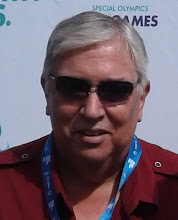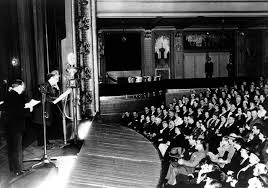He First Plays in Peoria: The Way It Was, 2 February
1890---And his first known punch line is the mighty cry at the doctor's slap: Charles Correll, the co-creator/co-writer/co-star of Amos 'n' Andy, is born.
He will work as a labourer and a silent movie house pianist as a young adult, before he's sent to North Carolina to stage a local lodge hall show. That's where he will meet Freeman Gosden, with whom he becomes fast enough friends that the two men become roommates as well as collaborators.
They will stage amateur acts for six years and become song-and-dance men otherwise (Correll at the piano, Gosden with a ukulele), before landing a weekly late-night slot on a small Chicago-area radio station. The Chicago Tribune will hear them and bring them to the larger station they happen to own, WGN . . . where the two white partners develop a character comedy about two black small business partners that becomes Sam 'n' Henry in 1925.
For a pair who think of radio as nothing more than a step toward the vaudeville bigtime, Correll and Gosden will make a local hit out of Sam 'n' Henry. They will learn the hard way, two years later, that they can't take it with them---the name, anyway---when they ask the Trib to let them record and syndicate the show to a thirty-five station chain. They move to WMAQ as Jim 'n' Charley and, later, Tom 'n' Harry, before finally settling for the name under which they will become a national phenomenon.
When a New York newspaper and a Chicago advertising executive (William Benton) notice the show, the ad exec will decide they're just what the dentist ordered for launching Pepsodent toothpaste. His superior, Albert Lasker, convinces NBC likewise---and Amos 'n' Andy go network 29 August 1929, with Correll and Gosden earning princely salaries ($50,000 a year).
Charlie Correll was more down-to-earth and blue-collar (than his partner Freeman Gosden)---he'd been a bricklayer---and much easier to talk to.---Hal Kanter, a writer on the later, weekly half hour variety-comedy version of the show.We weren't kidding race. We were kidding people---human nature---things that happened to anybody and everybody. Our characters depicted cross-sections of life. Everybody knew a wheeler-dealer like the Kingfish, living off his wits; or a blustering Andy, who never learned from experience. I knew a lot of people like that---they were relatives of mine.---Charles Correll, in 1972, recalling debates over whether two white men playing two black men was or wasn't racially demeaning.
CHANNEL SURFING
1951: OLIVER VAN METER'S ALLERGY---A series of allergies that begin on Monday, end on Friday, have weird timing and obscure enough roots that Kildare (Lew Ayers) considers suggesting his wealthy and influential patient look elsewhere for relief---risking the displeasure of a slightly awestruck board and Gillespie (Lionel Barrymore), on tonight's episode of Dr. Kildare. (Syndicated, based from New York WMGM.)
1960: AUDIENCE QUESTIONS---Approached and answered in their customary style of quiet absurdity, to open up today's edition of Bob & Ray Present the CBS Radio Network. (Three guesses.)
PREMIERING TODAY
1888---Frank Lloyd (director: Screen Guild Theater), Glasgow, Scotland.
1893---Len Doyle (actor: Mr. District Attorney), Toledo, Ohio.
1898---William Costello (actor: Betty Boop Fables), Rhode Island.
1899---Benny Rubin (actor/comedian: The Jack Benny Program, Benny Rubin's Whirligig Revue), Boston.
1901---Jascha Heifetz (violin virtuoso: The Bell Telephone Hour), Vilnius, Lithuania.
1911---Everett Freeman (writer: The Chase & Sanborn Hour [Eddie Cantor]; Baby Snooks), New York City.
1912---Stefan Schnabel (actor: Herbert Yost, Joyce Jordan, Girl Intern/Joyce Jordan, M.D.), Berlin.
1915---Frank Telford (producer: This Is Our Enemy), unknown.
1923---Bonita Granville (actress: Continental Celebrity Club, Stars Over Hollywood), Chicago; Haleloke Kahuaolapus (singer: Arthur Godfrey Time), Hilo, Hawaii.












0 Comments:
Post a Comment
Subscribe to Post Comments [Atom]
<< Home